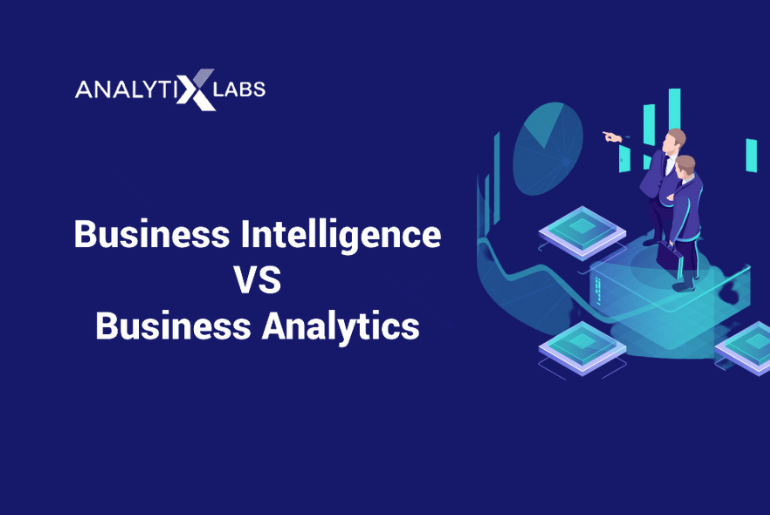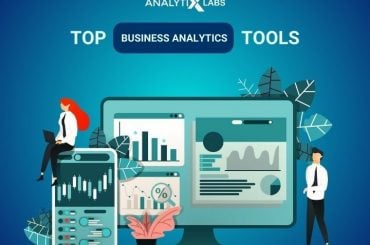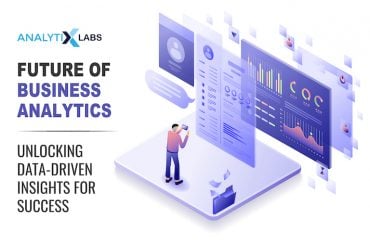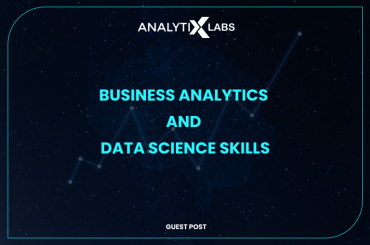Business Intelligence (BI) and Business Analytics (BA) are often used interchangeably. Whether one is the subset of the other is a debate, but these two overlap more often than not. Experts agree that BI and BA are different. Understanding the difference between business intelligence and business analytics is essential in making a more firm and informed decision on when to deploy and why. This article will highlight the difference between bi and ba, the techniques, tools, job details, and more.
Current students can also use this guide to decide which program to take for a successful career in BI or BA and accordingly prepare themselves .Understanding the Terminologies: BI vs BA
Business Intelligence and Business Analytics are not synonymous. While there are many similarities, these two solve distinct business problems.
Before deep-diving into the difference between business intelligence and business analytics, let’s take a simple example to understand the fundamental difference.
An individual ‘Arun’ is 40 years old. You have his historical data, like
- Personal details
- Demographics
- Hobby
- Goals
- Academic details.
Using these details, one can make clear conclusions to various questions like what is Arun’s score in his 12th, how many years he has been married, where he lives, what his birthplace is, where he works, etc. All these questions give you details on Arun’s past and present.
In a nutshell, you get all the information to understand the current state of Arun.
Now, put this example in a business setting. This is where business intelligence comes into play. With all the available information about a company, BI helps understand its current state based on its past and present.
Now, if we ask questions like:
- What will be Arun’s designation?
- What will be his salary?
- Why is Arun in a particular salary slab?
These questions are related to his past and present that can help predict the future.
Putting the same theory in business is what we call business analytics. Business analytics assess the reason for a company’s present state and predict the future based on all the information.
Also Read: Types of Business Analytics
BI vs BA: The Parameters
Various parameters or categories group the difference between business intelligence and business analytics.
(1) Scope
Business Intelligence deals with what is happening i.e. those events in the data that relate to the present and past. In contrast, Business Analytics deals with Why it is happening and what will happen in the future i.e. dealing with the historical data to assess the future.
(2) Usage and Application
- Usage:
Business Intelligence increases efficiency on a day-to-day basis by performing decision-making on a real-time basis, modifying standard operating procedures, etc.
On the other hand, business analytics enables the development of new products, forming of new strategies, and looking for opportunities by understanding market trends. It also helps improve the business’s overall health by identifying structural problems in the organization.
- Applications:
Business Intelligence deals with collecting data. It helps to keep track of performance, progress on achieving goals, and coming up with visually friendly insights to identify trends and report pitfalls. Descriptive statistics are often applied to get the results.
Business analytics applies statistics and data models to understand the reasons for current events and predict the next events with maximum accuracy.
(3) Type of Organization
Typically, small or new organizations focus more on business analytics as they need to know future business trends to adapt, innovate and survive quickly.
Larger and established companies focus on increasing efficiency by addressing day-to-day issues, streamlining workflows, and maximizing employee performance(i.e. BI).
(4) End-users
The end-users of the output generated from business intelligence and business analytics differ.
Business intelligence generates visual-friendly reports that managers and others consume in medium and high-level leadership. They form strategies and set medium & long-term goals.
Business analytics results are consumed by technical people such as analysts, accountants, and ML engineers who need hands-on experience with data to interpret it and develop actionable insights.
(5) Deliverables
In business intelligence, reports, dashboards, charts, and tables are formed that are typically easy to read and provide a holistic idea of the business’s current situation.
In contrast, business analytics is often statistical, and the output can be technical as analysts typically deal with coefficients, correlation values, and other statistics.
(6) Job Role
Individuals involved in business intelligence typically have a managerial background or good business acumen. Here, deep technical knowledge is not required as most of the work done under BI requires basic arithmetic. BI tools can easily generate such reports. It’s the interpretation of those reports in a business environment that is important.
Business analysts are good with statistics and other technical aspects required to model data. From a practical, particularly career point of view, we can also understand the difference by analyzing the salary difference between business intelligence vs business analytics.
While the difference between the two job roles is not much, the average salary of a business intelligence analyst is slightly higher than that of a business analyst. Still, the difference quickly fades as several factors affect the wages, such as work experience, nature of work, etc.
(7) Tools
Tools used in BI are typically more GUI-based, whereas, in data analytics, the tools require software application. In BI, tools typically create pivot tables, charts, dashboards, etc.
Business analytics tools are for predictive modeling and can often do the tasks required in business intelligence (but not the other way around).
Typical BI tools include SAP, Spotfire, QlikSense, TIBCO, Tableau, PowerBI, etc., whereas business analytics tools include SAS, R, MS Excel, etc.
(8) Statistical Methodologies
Business Intelligence is descriptive as it simply tries to answer the current standing of a business and uses descriptive statistics.
Business analytics tries to estimate the future and draw inferences based on the present. Also, it gets into prescriptive analytics and assesses the reason for what is happening and ways to perform better.
All this requires different statistics streams such as inferential statistics, regression, econometrics, etc.
Putting everything together, here’s a quick look at the difference between business analytics and business intelligence.
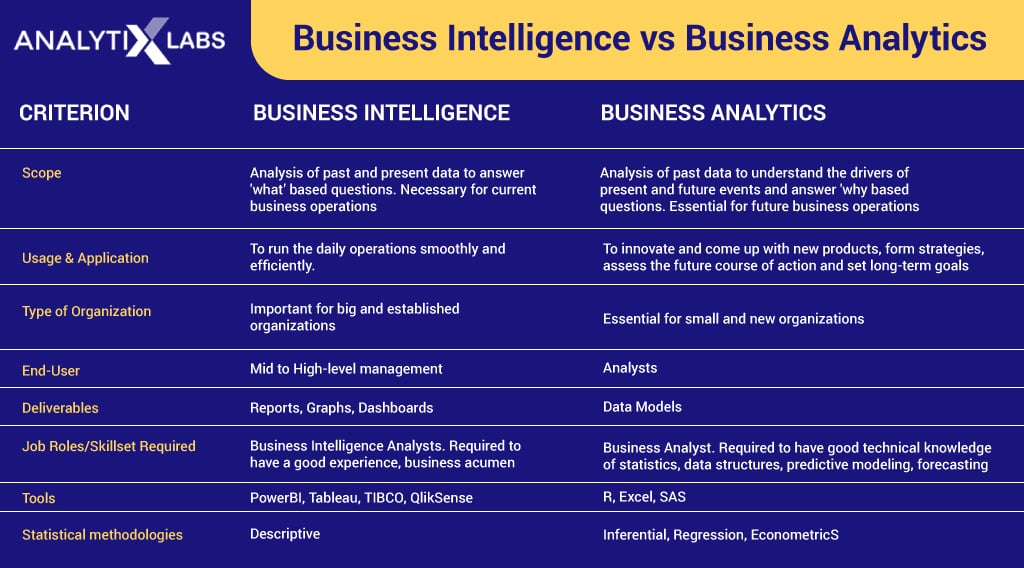
BI vs BA: Industry Applications
Business intelligence and business analytics are part of the same puzzle. They both are equally essential for a business to thrive and survive. Together, BI and BA answer two most important questions –
- What is happening and Why?
- What are the next consequences?
Businesses are doing everything to understand the application and implications of using BI and BA across various verticles. Here are some of the common industry applications of BI and BA.
-
Marketing
The most extensive use of Business Intelligence in marketing is to identify how well a market campaign is performing with respect to the associated cost. A marketing team can understand how much money they have spent and its return (like the number of clicks, views, conversions, and acquisitions obtained from each) through BI.
This can help reduce marketing costs, identify the best campaigns, and check if the ROI is as expected.
Consequently, Business Analytics can significantly help in budgeting based on the tentative marketing campaign cost. It can also help predict viewers’ responses to certain ads and the best time to make them available for maximum impact.
-
Human Resources
A Human Resource department is critical to every company. Business Intelligence (BI) and Business Analytics are crucial in an HR Department.
The BI aspect solves the what. In a practical setting, BI can help HR executives understand essential elements of the hiring process, which can include:
- The average time and cost of hiring individuals for different job profiles
- Understanding the recruiting funnel
- Types of procedures and references involved, etc.
Through BI, HR executives can identify departments taking more time and cost to hire individuals and determine the best processes to optimize the workflow.
Similarly, BI can manage attrition by identifying the departments and job profiles where attrition is most severe.
Business Analytics solves the why, i.e., why the hiring cost or time for a specific department or job profile is high or why there is a high level of attrition in particular departments.
By understanding the reasons, HR teams can create a new efficient procedure to reduce hiring costs or take pre-emptive actions to reduce attrition by identifying potential churners from the organization.
-
Finance
Using Business Intelligence in finance is extremely important for any organization’s financial stability and well-being.
You can monitor the cash reserves, cash outflows, cash conversion cycle, expenses, vendor payment rate, pending debts, and potential taxes through BI.
In short, BI helps to constantly monitor an organization’s asset vs. liability situation .
This can significantly help make important decisions such as maintaining working capital, addressing debt obligations, allocating compensation for the workforce, etc.
Business Analytics helps identify the reasons for the current financial situation and how it will be in the future. This results in efficient budgeting and consequent actions to increase financial stability.
-
Sales
Business Intelligence enables sales by analyzing the historical sales figures to understand the patterns, trends, cycles, time to complete a cycle, locations and products returning the highest sales, etc.
This can be coupled with identifying high and low-performing sales executives, processes followed by them, and analyzing other information about them. The use of BI can help the management identify the potential pitfalls in their sales strategy.
On the other hand, Business Analytics uses these historical data trends to understand how the sales would be in the foreseeable future and the contribution of different products.
-
Customer Loyalty
Customer loyalty is of utmost importance, particularly for any customer-driven company.
BI helps an organization understand its loyal customer base. For example, BI helps understand loyal customers’ different segments, average age, income, preferences, behavior, etc.
Business Analytics predict their retention span.
By combining business intelligence and business analytics, a company can design products or schemes to reduce customer churn and increase customer satisfaction, making them stay and remain loyal.
-
Inventory Management
Inventory management is essential for companies, especially those manufacturing or dealing with perishable items.
Business Intelligence can help know the current state of warehouses, i.e., their available capacity, state of items stored, etc.
When combined with business analytics, it can predict the future availability of stock, their cost, etc.
For example, with BI and BA –
- You can stock those items whose availability will be less in the future
- Things that are about to expire can be managed and sold at a priority
- High-value products can be tracked in a better manner, etc.
This brings us to a closure of understanding how business intelligence and business analytics function together but differ. This also means the job responsibilities of a business intelligence analyst and a business analyst are also different [with some functions overlapping].
Business Intelligence vs Business Analytics
-
Job role
Business Intelligence analyst deals with the present state of a business and answers the ‘What’ or ‘How’ question, i.e., what is the company’s state, how the company is performing in different aspects, etc.
The BI analyst looks at the historical data and gives insights into what and how the operations were performed and what result was achieved.
Business analysts go a step further and estimate the company’s future state and address the ‘Why’ questions, i.e., why is the current state of the business the way it is and estimate the future situation of the company.
Below is an example of job descriptions for both roles:
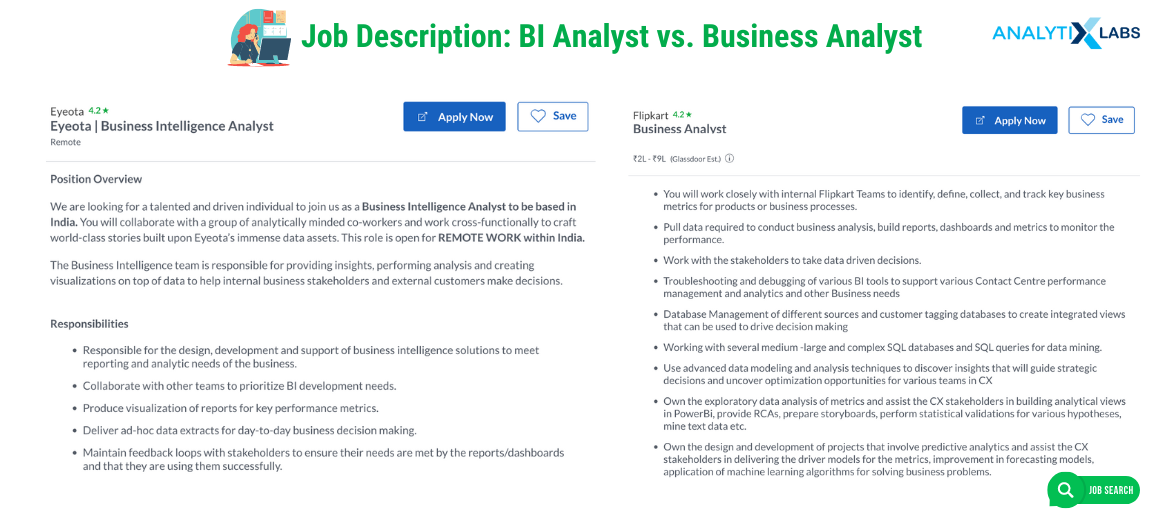
-
Salary
Business Analysts [beginners] in India earn INR 7,00,000/annum on an average. Highly experienced business analysts can earn around INR 16L/annum to start with.
Business Intelligence Analysts [beginners] in India earn around INR 7,60,000/annum on an average. Experienced professionals can earn around INR 18L/annum and above.
-
Career Path
Both domains offer different career paths for a student. Courses in analytics will lead them to be analysts (no prizes for guessing!), data scientists and similar professionals while someone trained in BI technologies can bag the roles of administrator, consultant, or manager.
Knowing the differences between both domains enables students and budding professionals to make the right career choices and helps business users to buy the right technologies and skills for their intended results.
You can also enroll in our Business Analytics Course and learn all the fundamentals and advanced aspects at your convenience, or you can book a demo with us.
Relationship between BI and BA
Interestingly, there seems to be widespread confusion about the difference between BI and BA. Both Gartner and OLAP, define analytics as a subset of BI. However, as we’ve just explained, there is another line of thought altogether that says that BI is a subset of BA, which is the greater purpose that drives the business forward.
The relationship between BI and BA has been made even more confusing by the rapid rise of new technology in both domains and a rush to make them more marketable. Therefore, the buzzword ‘intelligence’ seems to be more appealing than the more ubiquitous ‘analytics,’ or perhaps it is easier to capture a broader range of purposes by terming it as BI.
Some industry experts have even defined their relationship as a ‘generation gap.’ While earlier the impetus was on gathering Business Intelligence, the current overload of data thanks to digital disruption has shifted the focus more on gathering actionable insights from the data that is available. In other words, companies were more concerned with finding out what’s going on earlier, but now they want to know what they can do in the future.
In this sense, we can say that Business Analytics has taken over from Business Intelligence as the end purpose of data science.
Closing Note
- Does business intelligence include analytics?
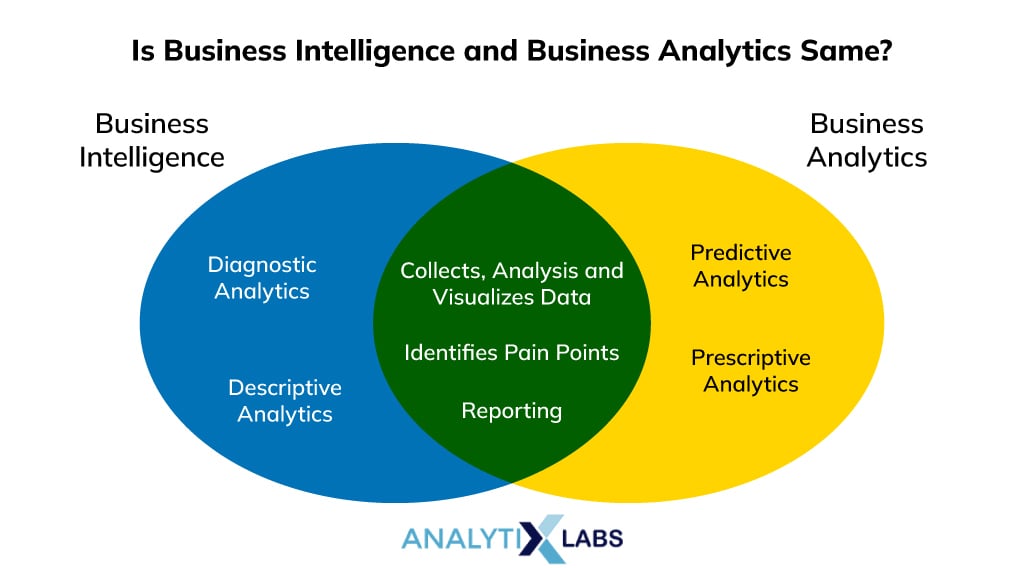
There is a heated debate among the business experts on whether business analytics is a subset of business intelligence or vice -versa.
The question becomes particularly difficult as both streams overlap including activities such as the collection of data, reporting, visualization, etc.
Therefore, there are few similarities between business intelligence and business analytics.

